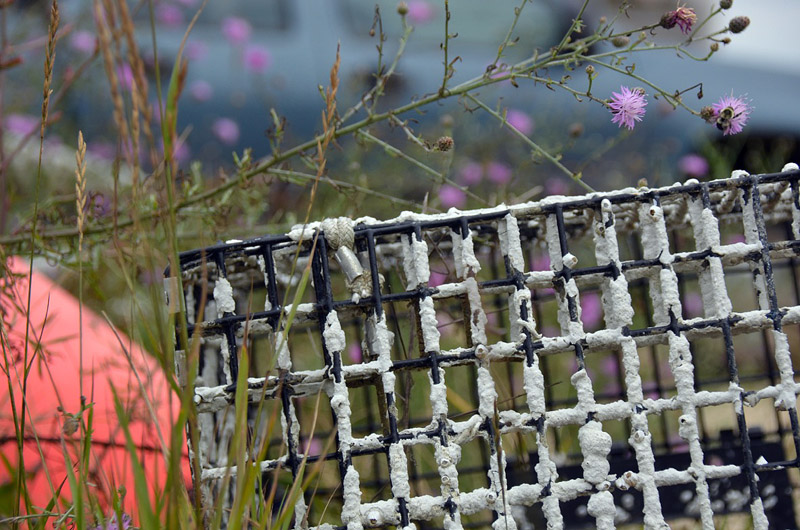Wes Brighton looked out the window of his 40-foot fishing boat the Martha Elizabeth — among the largest docked at Menemsha harbor on Monday evening — at the picturesque shacks and wooden piles lining the dock behind the fish markets.
“Every vacationer makes Menemsha at least one night on their two-week vacation,” he said, ticking off the benefits of commercial fishing to the Island.
A group of young fishermen farther down the dock chatted quietly about day-to-day business. To the north, a crowd of visitors on the beach grew as the sun neared the horizon.
“It’s a year-round job that doesn’t actually entail a direct relation to tourism and the building industry,” Mr. Brighton said. And while most of the locally-caught fish is exported, most fishermen live here year-round and their profits stay in the community.
Across the harbor, the famed Unicorn dragger, now rusted and unseaworthy, glowed in the sunlight, a reminder of brighter days for the Island fishing industry.
The decay of the Unicorn, and that of her sister ship, the Quitsa Strider II (now gone), has little to do with a lack of fish, Mr. Brighton said. Instead, he said, the main struggle for fishermen these days involves the array of state and federal regulations and the ever-increasing costs associated with a way of life as old as the Island itself.
“It’s because we lost our access to those fish,” Mr. Brighton said. “And if we want to feed our community fresh, local product that’s sustainably harvested we need access and we need to get back in.”
Many of the fisheries around the Vineyard have declined as a result of commercial fishing. In 2009 a new regulatory system based on sectors and annual quotas replaced the previous system, which worked by limiting fishing trips and days at sea. But the new system tends to favor larger companies that can afford to purchase quota from other fishermen and reinvest in equipment.
The fisheries have largely rebounded, Mr. Brighton said, but the Island’s commercial fishing fleet is struggling to compete with companies in New Bedford and other large fishing ports in New England.
Along the coast, however, community groups have emerged to reclaim some of the access to their local waters. The Martha’s Vineyard Fishermen’s Preservation Trust, a small group of fishermen, businessmen and others, is now working to establish a permit bank to make permits and quota affordable and keep them in the community.
The most active fisheries on the Vineyard — conch, lobster and monkfish — are managed by limited access (only a certain number of permits are issued). But groundfish, which include cod, flounder, haddock and other bottom-dwelling species, are regulated in part by quotas, which can be bought and sold on the open market. As one project, the trust plans to raise money through loans, grants and donations to buy quotas and lease them to fisherman at an affordable rate.
Obtaining a quota, however, requires first obtaining a state or federal permit, and most permits are already in use, placing them in high demand. A conch permit, for example, might sell for $40,000. A monkfish permit might exceed $50,000. A full-time scalloping permit for a large boat could easily run in the millions.
Quotas can be owned and leased by anyone, but permits are tied to individual vessels, so the trust would be hard-pressed to lease a permit without relinquishing control. “There is nothing keeping me from going to any other place in the world at fair market value and just selling it,” said Mr. Brighton, who is also a trustee for the fishermen’s trust.
“Obviously the hope is to one day be able to have boats that could lease quota,” said Shelley Edmundson, a Ph.D. candidate at the University of New Hampshire who is studying conchs and also working as treasurer for the trust. But the trust has raised only about $20,000 so far and has no immediate plans to purchase a boat.
With groundfish populations still struggling, fishermen have shifted to other fisheries, decreasing the demand for groundfish permits, said Christopher McGuire, marine program director for The Nature Conservancy, which is helping the trust with fundraising, logistics and permit acquisition.
“This is a speculative time to buy groundfish permits because their value is really low,” he said. “The groundfish complex was once amazingly productive. If the changes in Massachusetts have a positive impact in a few years, if there are no permits on the Vineyard it’s going to be really hard to get them back.”
On the other hand, he said, if the trust purchases those permits and the value goes up in a couple of years, “that might be a windfall for the community.”
But partly as a result of the new regulatory system, there are few groundfish permits here to begin with. Obtaining a permit requires first obtaining a qualifying permit, which is issued to fishermen according to their catch sizes in certain years. The qualifying permits for groundfish were issued at a time when few people on the Vineyard were working that fishery, so the quotas went elsewhere.

“From the vantage of a Vineyard fisherman, there is no access left to the groundfish,” said Paul Parker, director of the Cape Cod Commercial Fishermen’s Alliance, which is also offering assistance to the Vineyard trust. “It was basically regulated away.”
Mr. Parker believes that most fishermen agree with the principle of limited access and quotas as a way to preserve fisheries and ensure some long-term job security. But he also sympathized with the entry-level fishermen who struggle to make ends meet. “How do you suddenly shift the playing field to make it possible for small-boat fishermen to not just compete but to thrive?” he said.
Among other things, the Cape Cod alliance manages a large permit bank, leasing quotas for scallop, groundfish and surf clam fisheries at about half the market rate. During the last decade, it acquired a peak of about $2.6 million in debt, which is now down to about $1.5 million. Initial funding came from a variety of groups, including Cape Cod Five Cents Savings Bank, the Ford Foundation and the Calvert Foundation.
“One of the things that a lot of fishing communities are surprised to find out is there is a tremendous amount of interest in sustainable fisheries,” Mr. Parker said. “People want to make a social and environmental difference and are interested in meeting folks like the preservation fund on the Vineyard.”
“We have been able to help bridge the gap between community permit banks and some of the impact investors out there,” he added. The alliance is now working with the Vineyard trust to develop a case statement for applying for loans and grants.
“They have an amazing organization,” Mr. Brighton said of the alliance. “We would be really lucky to have even a fraction of the amount of quota that they have access to.”
He acknowledged that some regulations have been beneficial, but he still sees the industry as over-regulated. Ducking below deck, he retrieved a gray box about the size of a laptop computer.
“Every time I leave the dock I have to write the feds an email and put in a specific code that tells them whether I’m fishing within the regulated fishery or [outside] it” he said. The required box and antenna cost about $3,000, not including an $80 monthly subscription fee.
Some fishermen must also carry a certified observer on 25 per cent of all fishing trips. During the transition to the quota system, observers were paid through federal funds. “Now that funding is drying up, so they will have to be completely funded by industry for the multi-species [groundfish] permit,” Mr. Brighton said.
With increasing costs and complexity, many small-scale fisherman simply give up. Young fishermen especially require affordable access to fisheries. “It’s incredibly expensive to buy into the infrastructure and simultaneously have access,” Mr. Brighton said.
In addition to buying and leasing quotas, the Vineyard trust plans to develop a revolving loan fund to assist fishermen with various efforts related to their business. Acquiring a loan can be especially challenging for young fishermen without capital or a mortgage, Ms. Edmundson said, and the trust could absorb the risk.
After a period of dormancy last year, the trust’s board of directors began meeting frequently, and three public meetings have been held since October, offering local fishermen and others a chance to comment on the various efforts underway.
“The challenge is communicating your purpose,” Ms. Edmundson said. “And unless you have people come to these meetings, you can’t really express what your goals are. It’s been a slow process, but I think the word is spreading and people are understanding what we are hoping to do.”
On August 6, the trust will host a first-of-its kind Meet the Fleet event at Menemsha Harbor, where the public can learn about the industry and talk with local fishermen.
“The majority of people that come to Menemsha and the Vineyard want to see a thriving, local, and owner-operated seafood harvesting industry,” Mr. Brighton said. “We want to please those people and make sure they know that this is a good cause.”








Comments
Comment policy »